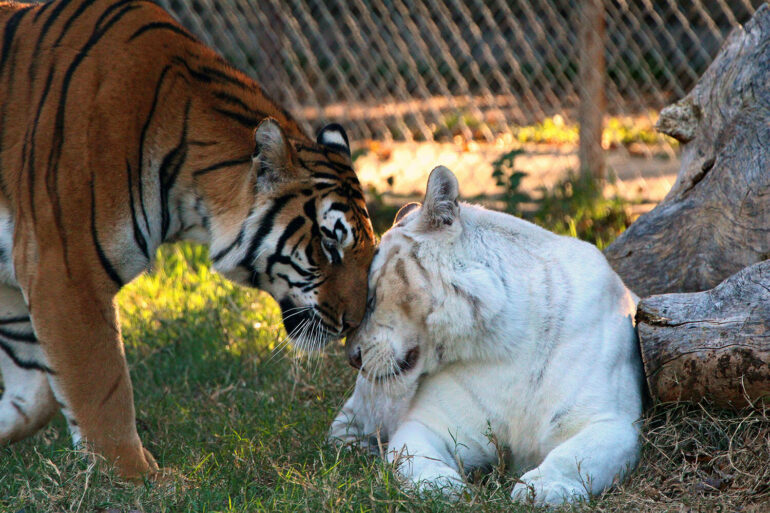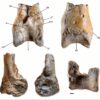Captive tigers in the United States outnumber those living in the wild. The World Wildlife Federation estimates around 5,000 of the big cats reside in the U.S., mostly owned by private citizens.
The health of this population is a genetic mystery for conservation groups and researchers interested in how the captive tigers could help stabilize or restore wild tiger populations. Are the privately owned animals just like tigers in the wild, or do they reflect characteristics popular in the illegal trade? Are they a hodgepodge of wild tiger ancestry, or are they detrimentally inbred?
New research from Stanford University, published Sept. 19 in Proceedings of the National Academy of Sciences, digs into these questions and offers a new tool that conservationists and law enforcement can use to protect the animals and prosecute those responsible for their abuse.
“We’re trying to leverage genomic technology to be useful in a conservation context—there are so few tigers. We won’t get a second chance if they go extinct,” said Ellie Armstrong, Ph.D., who is lead author of the paper.
An unknown population
The study was led by Armstrong, who conducted the research as part of her doctoral studies in biology, with her co-advisors and co-authors Elizabeth Hadly, the Paul S. and Billie Achilles Professor in Environmental Biology, Emerita; and Dmitri Petrov, the Michelle and Kevin Douglas Professor, both in the School of Humanities and Sciences.
The researchers became interested in studying the genetic diversity of privately held tigers—called “generic” because their sources are unknown—after conducting a study on the genetic impact of the isolation of wild tiger populations.
“We were conducting a large study on wild tiger populations and leveraged these data to address the issue of captive tigers in the United States. It was a bit unbelievable, at first, that you could have a tiger living right next door and not know it,'” said Armstrong, who is now an assistant professor of evolution, ecology, and organismal biology at the University of California, Riverside.
“We got connected with Tigers in America, and that’s when we realized that there’s an enormous number of these cats outside of accredited facilities that were bred for animal encounters, performed as circus animals, or were trafficked as exotic pets. But we didn’t have any idea what kind of tiger they were or where they came from,” Armstrong continued.
A hurdle for the research team was the absence of official data on generic tigers. Shows like Netflix’s 2020 “Tiger King” and the 2009 documentary “The Tiger Next Door” helped increase public knowledge of the problem of privately owned tigers, but accessing the animals for research purposes was still a challenge.
“There was so much hearsay associated with this captive population and a lot of it contradicts itself. People said, ‘All of the cats are really inbred,’ or ‘All of the cats are genetically diverse,'” said Armstrong. “We had no idea what to expect and thought that genomic technology could help us answer some of these questions.”
Building a genetic database
Through relationships with sanctuaries that had rescued generic tigers, the team obtained samples and learned about the tigers, including the rescue locations for many animals.
The researchers collected samples from 154 generic tigers and used another 100 available wild tiger samples existing in the National Center for Biotechnology Information (NCBI) database. From their previous work, the team knew that there are six wild subspecies of tigers. With these data, they developed a reference panel for tigers that was used to accurately distinguish individual animals and assign their genetic ancestry. Armstrong compares it to the popular genetic ancestry tests for humans.
“When we do 23andMe, we’re not sequencing the whole genome—we’re sequencing a portion of it that informs us about your health and ancestry,” she said. “That’s what we want to be able to do, but for tigers. It’s difficult and expensive to sequence and analyze a whole genome, especially in a conservation context. The workflow we built allows you to sequence a portion of the genome and get answers about the tiger individual and its ancestry.”
A boon to law enforcement
Knowing a tiger’s ancestry has uses beyond conservation and breeding programs—law enforcement can use it to prosecute.
The Big Cat Public Safety Act went into effect Dec. 20, 2022, ending the private ownership of big cats as pets and placing restrictions on breeding, commerce, possession, and use of certain species, including tigers. (Individuals who owned cats prior to the law passing must register the animals.) Still, the U.S. Fish and Wildlife Service has storerooms full of confiscated tiger pelts, bones, teeth, etc., and cases they are unable to prosecute because they are unable to positively identify the origin and ancestry of the samples. The agency has already requested to work with the researchers.
“We’ll be working with law enforcement to try to apply this in a forensic context to prosecute wildlife crimes like those seen in ‘Tiger King,’ monitor the populations in the U.S., and track the illegal trade,” Armstrong said. “Materials like teeth and pelts have limited DNA in them, and the reference panel we built here can allow wildlife agencies to determine the ancestry and identity of confiscated samples, even by only sequencing a small portion of the genome. That’s been the most rewarding part of this research—we know that this work mattered and has immediate future applications.”
Putting rumors to rest
As for those wondering, “What are these animals?” the researchers feel they can put this question to rest. The U.S. captive tiger population did not show widespread inbreeding relative to wild tiger populations. Nor did they show that the generic tigers maintain single subspecies ancestry, as is true of zoo-bred tigers or tigers in the wild.
These generic tigers are a mix of different tiger subspecies. Armstrong and colleagues also show that the non-zoo captive tiger population in the United States does not harbor more genetic diversity than that found in wild populations.
“This absence of unique genetic diversity in captive tigers means that there will be no ‘genetic rescue’ of wild tigers with individuals now in captivity,” Hadly said. “In other words, the genetic diversity of wild tigers is all that evolution has to work with going into the future.”
DNA is the only way to identify a tiger subspecies—there are no distinguishable physical differences in the six recognized subspecies. If the unique evolutionary histories of individual tiger subspecies remain a priority for tiger management, and we can overcome the enormous hurdles of releasing captive animals back into the wild, the reference panel could be used to identify individuals that do not have mixed ancestry.
Said Armstrong, “This technology is usually a ‘for fun’ thing for humans, to find out more about your genetic ancestry, but we can use genomics in a very serious way to help our wildlife populations thrive in the wild and keep them from being exploited.”
More information:
Ellie E. Armstrong et al, Unraveling the genomic diversity and admixture history of captive tigers in the United States, Proceedings of the National Academy of Sciences (2024). DOI: 10.1073/pnas.2402924121
Provided by
Stanford University
Citation:
Can captive tigers be part of the effort to save wild populations? (2024, September 19)



